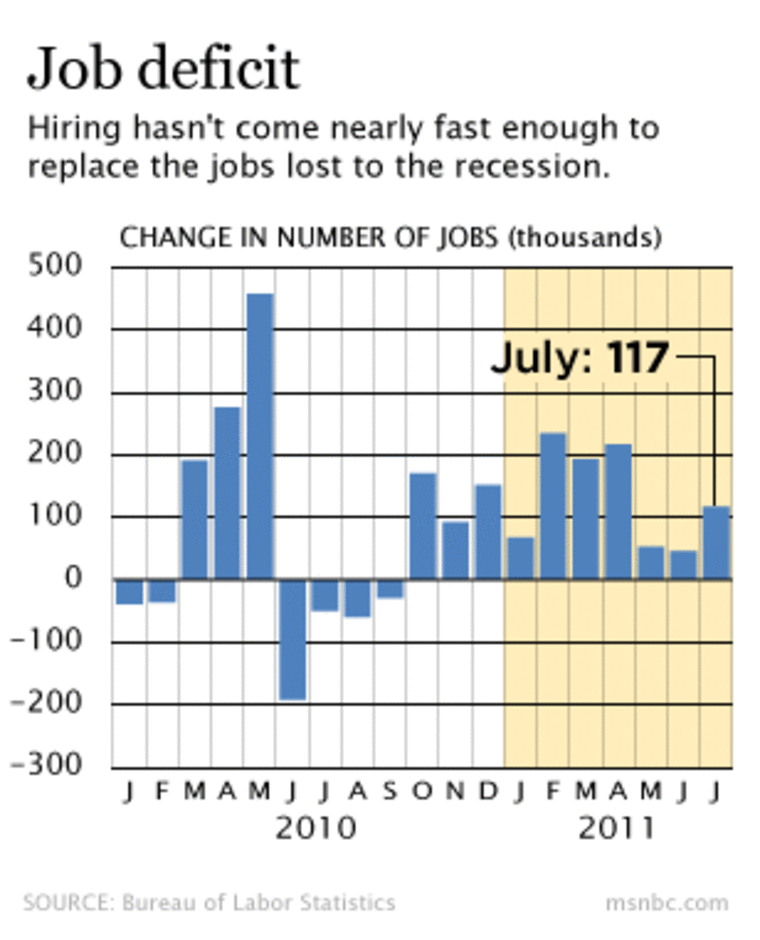The U.S. may have dodged the double-dip bullet with the latest jobs data, but there is little more the government can do to rev up an economy stuck in first gear.
As the impact of trillions of dollars of government stimulus continues to fade, Congress and President Barack Obama have few tools left to revive growth. Federal Reserve policymakers meet next week, but their toolbox may contain little more than bubble gum and wire.
The government's monthly job report pointed to a surprise uptick in hiring in July. Payrolls expanded by 117,000, the Labor Department said on Friday, as private employers added 154,000 workers. That offset the continuing shrinkage of federal, state and local government payrolls, which cut 37,000 positions in July, a ninth straight month of government job losses.
The gains helped the unemployment rate edge down to 9.1 percent from 9.2 percent in June. Job counts for May and June were revised to show 56,000 more jobs added than previously reported.
"This is a fabulous number," said Mark Zandi, chief economist at Moody's Analytics. "We're not out of the woods yet, but this is a good sign that we are going to avoid recession."
Recession fears have risen in the past few weeks as economic data have pointed to a recovery losing steam. The nation's gross domestic product, the broadest measure of economic activity, grew at a sluggish 1.3 percent annual rate in the second quarter, according to initial estimates, and only 0.4 percent in the first three months of the year, according to the latest revision.
Private economists have been slashing growth forecasts for the second half of the year. Most still expect a modest pickup as the impact of higher oil prices fades and the auto industry shakes off a slowdown in shipments from Japan following March's earthquake.

That overall outlook masks a very uneven recovery: Job growth varies widely from one industry to the next. Two years after recession technically ended, the housing and construction industries remain at deep recessionary levels. On the other hand, as businesses invest in more equipment and technology to boost productivity, computer engineers and IT consultants are in high demand.
Companies are still hiring, according to Tig Gilliam, head of the North American region for Adecco Group, a global human resources company
"If we were going into the double-dip recession, we would see companies cutting temporary employees in large numbers," he said. "That's the first place they go — it's the first reaction to reduce costs. They're not doing that."
Gilliam said most large companies have plenty of cash to keep workers on the payroll as they look for new business. Then they can hire selectively.
A closer look at Friday's jobs data reveals continued underlying weakness in the labor market. While the payroll survey provided good news, a separate survey of households showed a drop of 38,000 jobs in July, the third decline in four months. The jobless rate fell because 193,000 people left the work force. Measured against the total working-age population, employment fell in July to 58.1 percent, a 28-year low, according to Paul Dales, senior economist at Capital Economics.
Bigger picture
"The bigger picture, then, is that two years after the recession ended the labor market has not really recovered at all, and may even have gone backwards," he said.
The recent slowdown in recovery coincides with the fading impact of the government's massive stimulus package following the worst financial collapse since the Great Depression. To jump-start the economy after a virtual shutdown in lending, the government devoted roughly $1.5 trillion to bail out the banking system and boost government and consumer spending.
In addition, the Federal Reserve has purchased roughly $2.3 trillion in bonds to pump cash back into the financial system.
The central bank's latest round of $600 billion worth of bond-buying ended in June. A series of weak economic data in July prompted speculation the Fed might start buying another round of bonds to pump even more cash into the system. But with companies already hoarding cash, it's not clear that would have much impact.
"We have $600 billion of stimulus already out there, and it has made a marginal difference," said former Fed governor Mark Olson. "You add another trillion to the $600 billion and then you look at the difficulty of unwinding that, and I think there will be real reservations to move forward. "
As the bitter battle over the debt ceiling showed, there is no appetite in Congress for any additional spending to stimulate the economy.
"There are very few cushions available," said Mohamed El-Erian CEO of PIMCO, the giant investment firm. "The policy responses are limited both by ineffective tools and dysfunctional politics."
Even with the best policy tools and the most favorable political climate, the damage from the financial collapse of 2008 would take years to repair. Unlike prior cyclical downturns in demand, the Great Recession was caused by the aftermath of the worst financial collapse since the 1930s. After a decade of unsustainable government and consumer borrowing, the economy is slowly working off the trillions of dollars of debt that remains. Some analysts believe the process could take years to complete.
"The aftermath of those rare, financially driven recessions is slow, painful, and protracted," said Roger Altman, an investment banker and former Treasury official. "That's exactly what we're seeing. It's going to take a while for us to rebuild ourselves."